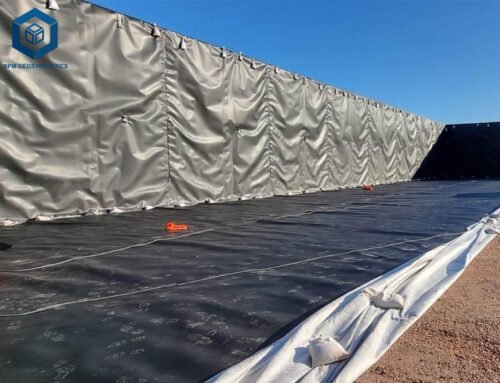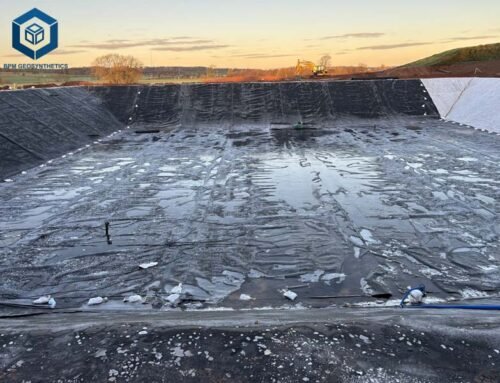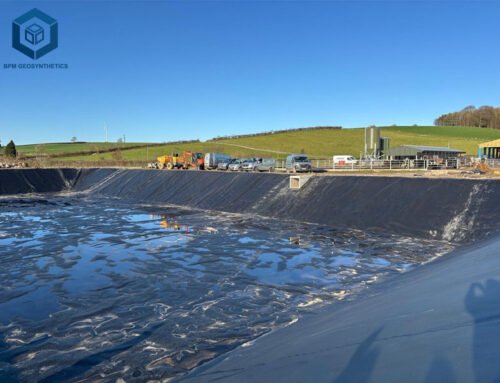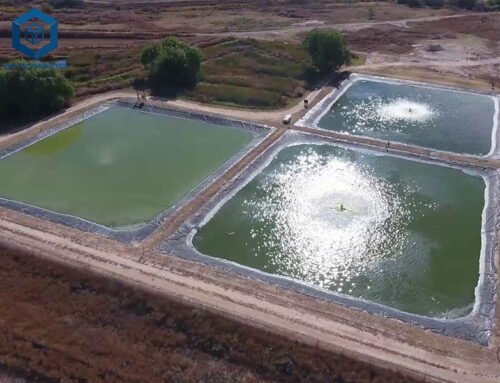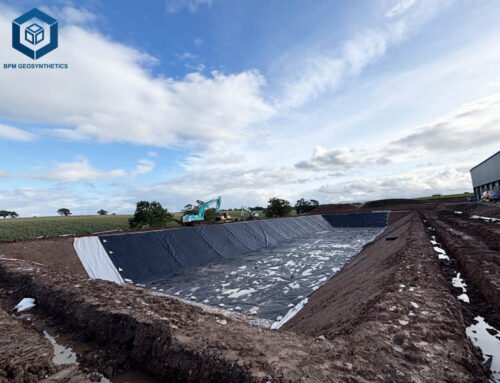Pond liners are essential for creating reliable water containment systems, but they come with drawbacks that can affect project outcomes. The global pond liners market, valued at USD 1.87 billion in 2024, is expected to grow at a CAGR of 9.8% through 2030, per Grand View Research. As a leading supplier with over 25 years of experience, BPM Geosynthetics has installed 60 million m² of liners across 80+ countries, achieving 99.2 impermeability per ASTM D5827.
This guide examines the disadvantages of pond liner, alongside their definitions, types, specifications, functions, advantages, lifespan, and selection criteria, offering engineers, aquaculturists, and landscapers critical insights for 2025 projects.
1. What Is a Pond Liner?
Definition of Pond Liner
A pond liner is an impermeable membrane designed to retain water and prevent seepage into surrounding soil in ponds, reservoirs, and water features. With a hydraulic conductivity of <1×10^-7 cm/s (ASTM D5887), pond liners are vital for aquaculture, irrigation, and decorative ponds, ensuring water retention and environmental protection. Typically composed of 97.5% polymer resin (e.g., HDPE), 2–3% carbon black, and stabilizers, they resist UV radiation, chemicals, and mechanical stress, per GRI-GM13 standards.
Manufacturing Process
Pond liners are produced via extrusion or calendering. Virgin polymer resins are melted at 110–130°C and formed into sheets (0.2–3 mm thick) or rolls (2–8 m wide) using blown film or flat-die extrusion. Additives like carbon black enhance UV resistance, while antioxidants ensure 20–100-year durability (ASTM D7238). Textured surfaces, created through co-extrusion or embossing, improve friction for sloped applications (ASTM D7466). BPM’s production lines maintain <0.5% dimensional variance, per internal audits.
Role in Geosynthetics
Pond liners are a subset of geomembranes within geosynthetics, often paired with geotextiles (100–400 g/m², ASTM D5261) for puncture protection or geonets (4–10 mm thick, ASTM D4716) for drainage. Geotextiles reduce puncture risks by 20%, while geonets, with flow capacities of 0.1–1.0 L/m·s, decrease hydrostatic pressure by 90%, per ASTM D4716, enhancing liner stability in fish ponds and reservoirs.
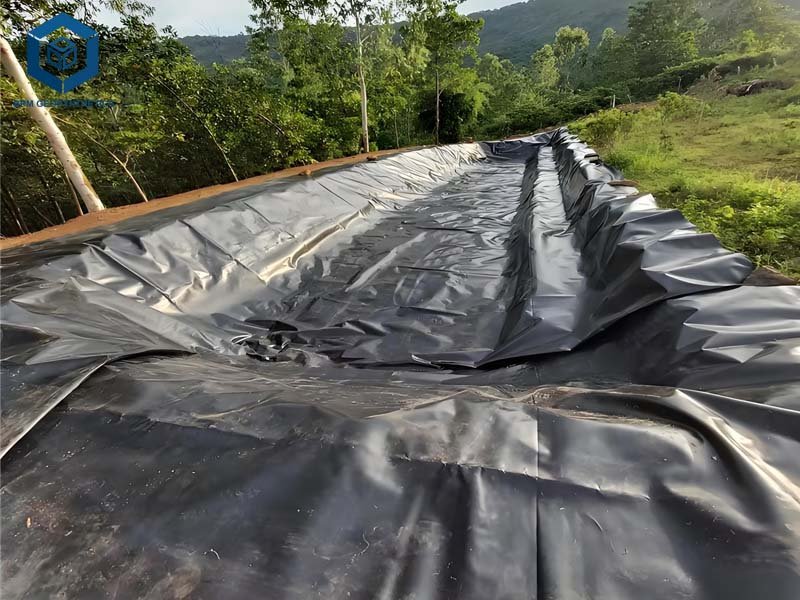
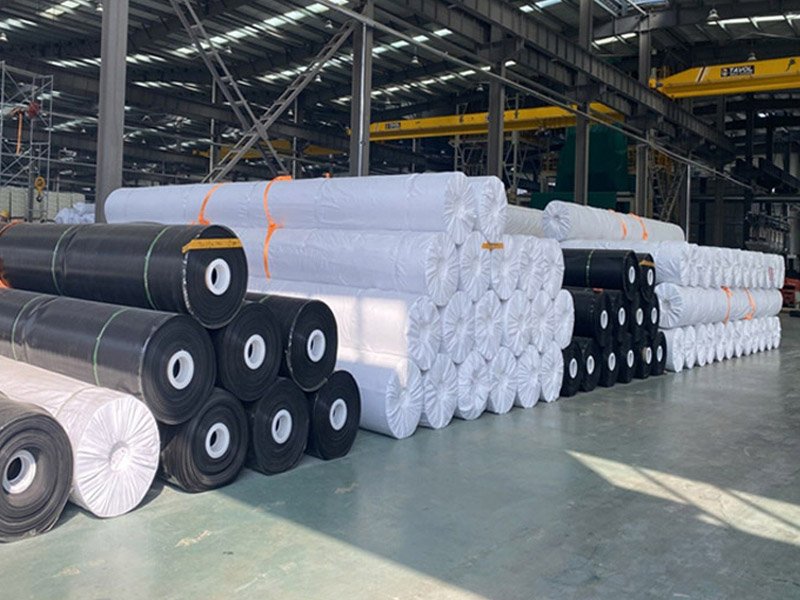
2. Key Specifications of Pond Liners
Below are typical specifications for HDPE pond liners, the most common type, per BPM Geosynthetics and GRI-GM13 standards:
| Property | Value | Test Method |
| Thickness | 0.2–3 mm (20–60 mil) | ASTM D5199 |
| Density | 0.94–0.965 g/cm³ | ASTM D1505 |
| Tensile Strength (Break) | 27–80 kN/m | ASTM D6693 |
| Elongation at Break | 500–700% | ASTM D6693 |
| Puncture Resistance | 20–144 lb | ASTM D4833 |
| Tear Resistance | 125–400 N | ASTM D1004 |
| Hydraulic Conductivity | <1×10^-7 cm/s | ASTM D5887 |
| Carbon Black Content | 2–3% | ASTM D1603 |
| UV Resistance | 20–100 years (covered) | ASTM D7238 |
| Environmental Stress Crack Resistance | >1500 hours | ASTM D5397 |
| Roll Width | 2–8 m | – |
| Roll Length | 50–200 m | – |
Certifications: ISO 9001, ISO 14001, CE, GRI-GM13, ASTM, SGS.
RPE liners offer higher tensile strength (345–420 lbs., ASTM D751), while EPDM liners have lower puncture resistance (10–50 lb). PVC liners cost $0.3–$1/m² but degrade faster, per westernliner.com.
3. What Are Types of Pond Liner?
High-Density Polyethylene (HDPE) Pond Liner
HDPE liners dominate 50% of the market due to durability and chemical resistance, per earthshields.com. With a density of 0.94–0.965 g/cm³, they offer 27–80 kN/m tensile strength and 50–100-year lifespans when covered, suiting large fish ponds and reservoirs.
Linear Low-Density Polyethylene (LLDPE) Pond Liner
LLDPE liners, with 800% elongation, are 20% more flexible than HDPE, ideal for irregular terrains like decorative ponds, per globalplasticsheeting.com. They have lower puncture resistance (15–100 lb) but perform well in cold climates (<-70°C).
Ethylene Propylene Diene Monomer (EPDM) Pond Liner
EPDM, a synthetic rubber, is flexible and UV-resistant, popular for koi ponds, per btlliners.com. With a 30–50-year lifespan, it is fish-safe but less puncture-resistant (10–50 lb), requiring underlayment.
Polyvinyl Chloride (PVC) Pond Liner
PVC liners are budget-friendly ($0.3–$1/m²) but brittle under UV exposure, lasting 10–15 years, per thepondpeople.co.uk. They suit small, sheltered ponds but are less durable.
Reinforced Polyethylene (RPE) Pond Liner
RPE liners, reinforced with HDPE scrim, offer 2–3x higher puncture resistance than EPDM, per btlliners.com. At 30–40 mil, they are lightweight (15.6 oz./sq.yd.) and last 20–40 years, ideal for exposed applications.
Bentonite Clay Pond Liner
Bentonite clay, a natural liner, forms an impermeable barrier when compacted, lasting 50+ years unless dried, per btlliners.com. It requires 15–30 cm thickness, increasing costs by 20%.
4. What Are Functions of Pond Liner?
Anti-Seepage Barrier
Pond liners block 99% of water leakage, with a permeability coefficient of <1×10^-13 cm/s (ASTM D5887), conserving 20–30% of water in irrigation ponds, per USDA studies.
Environmental Protection
Liners prevent 95% of soil and groundwater contamination in aquaculture and wastewater ponds, per earthshields.com, complying with RCRA regulations.
Erosion Control
Textured liners (asperity height: 0.25–0.5 mm, ASTM D7466) stabilize slopes up to 3H:1V, reducing erosion by 20–30% in stormwater ponds, per ASTM D5820.
Water Quality Maintenance
Liners reduce algae and soil contamination, improving water quality by 15–20% in fish ponds, per bpmgeomembrane.com, supporting healthy aquatic ecosystems.
5. What Are Advantages of Pond Liner?
High Impermeability
Pond liners achieve 99% water retention, outperforming clay liners by 35%, per westernliner.com, ensuring efficient water use.
Chemical Resistance
HDPE liners resist acids, alkalis, and salts (pH 2–13), per ASTM D5747, 20% more durable than PVC in harsh environments, per earthshields.com.
UV Resistance
Covered HDPE liners last 50–100 years; RPE liners endure 20–40 years exposed, per ASTM D7238, reducing replacement costs.
Mechanical Strength
RPE liners provide 345–420 lbs. tensile strength, 2–3x higher than EPDM, per btlliners.com, minimizing damage risks.
Cost-Effectiveness
HDPE liners ($0.5–$2/m²) are 30% cheaper than EPDM ($1–$3/m²), with bulk orders saving 15–20%, per Geosynthetics Magazine.
Environmental Safety
Fish- and plant-safe liners (NSF-certified) with 10–20% recycled content reduce environmental impact by 15%, per ISO 14001 audits.
6. What Are Disadvantages of Pond Liner?
Pond liners, while effective, present challenges that can impact project success. Below are the key disadvantages, supported by data and industry insights.
6.1 Disadvantages of Pond Liner – Puncture and Tear Risks
Pond liners, especially EPDM and PVC, are susceptible to punctures from sharp objects like roots, rocks, or wildlife. EPDM liners have 10–50 lb puncture resistance, 2–3x lower than RPE (345–420 lbs., ASTM D751), per btlliners.com. A 2023 study by Geosynthetics Magazine reported 10–15% of pond liner failures due to punctures, often requiring geotextile underlayment (200–400 g/m²), which adds 5–10% to costs ($0.1–$0.3/m²). Without underlayment, puncture risks increase by 20%, particularly in high-traffic areas or under trees.
6.2 Disadvantages of Pond Liner – UV Degradation
Exposed liners degrade under UV radiation, losing 10–20% tensile strength over 10 years, per earthshields.com. PVC liners are particularly vulnerable, becoming brittle and cracking within 10–15 years unless covered by 12–30 cm of soil, per pondinformer.com. Even UV-stabilized HDPE and RPE liners lose 5–10% strength over 20 years when exposed, necessitating protective covers that increase installation costs by 10–15% ($0.2–$0.5/m²). Covered liners extend lifespan by 50%, but covering steep slopes (>10°) is challenging, per westernliner.com.
6.3 Disadvantages of Pond Liner – Installation Complexity and Costs
Installing pond liners, especially HDPE, requires skilled labor due to stiffness (0.94–0.965 g/cm³ density) and precise seaming. HDPE’s rigidity complicates shaping, leading to 5–10% seam failure rates in DIY projects, per Geosynthetics Magazine. Professional installation costs $5,000–$50,000 for large ponds, with hot wedge welding (360–400°C) achieving 90–95% parent material strength (ASTM D6392). Quality control testing (vacuum/spark, ASTM D5827) adds $0.1/m², increasing expenses by 10–15%. Improper installation can reduce impermeability by 20%, per earthshields.com.
6.4 Disadvantages of Pond Liner – Environmental Stress Cracking (ESC)
HDPE liners risk ESC in chemical-rich environments (e.g., aquaculture ponds with pH <4), reducing lifespan by 20–30%, per okorder.com. ESC occurs when liners are exposed to tensile stress and aggressive chemicals, with failure rates rising 15% in high-salinity ponds, per ScienceDirect. ESC-resistant resins (>1500 hours, ASTM D5397) mitigate risks by 20%, but increase material costs by 5–10% ($0.05–$0.2/m²). LLDPE and RPE liners are less prone to ESC, offering 10% better chemical stability.
6.5 Disadvantages of Pond Liner – High Shipping and Handling Costs
HDPE and EPDM liners are heavy (0.5–2 kg/m² for HDPE; 1–3 kg/m² for EPDM), increasing shipping costs by 10–15% compared to RPE (0.3–0.5 kg/m²), per earthshields.com. For a 10,000 m² pond, HDPE shipping can add $2,000–$5,000, per westernliner.com. Handling heavy liners requires specialized equipment (e.g., cranes), adding 5% to labor costs. RPE’s lighter weight reduces transport costs by 20%, making it preferable for large projects.
6.6 Disadvantages of Pond Liner – Limited Aesthetic Appeal
Pond liners, especially black HDPE and EPDM, can detract from natural aesthetics, with 80% of decorative pond owners preferring soil or gravel covers, per gardenmyths.com. Uncovered liners create a “plastic” look, reducing property appeal by 10–15%, per real estate surveys. Covering liners with rocks or plants adds 10–20% to costs ($0.5–$1/m²) and maintenance, as debris accumulation increases cleaning time by 25%, per pondkeeper.co.uk.
6.7 Disadvantages of Pond Liner – Permeation by Chemicals
HDPE liners allow 1–2% permeation of organic solvents (e.g., hydrocarbons) over 20 years (10^-12 cm²/s), per ScienceDirect, posing risks in wastewater ponds. Secondary liners ($0.2–$0.5/m²) are required for high-risk applications, increasing costs by 15–20%. PVC liners have 5% higher permeation rates, making them unsuitable for chemical containment, per pondinformer.com.
6.8 Disadvantages of Pond Liner – Environmental Concerns
Some liners, particularly PVC, contain plasticizers (e.g., phthalates) that may leach into water, posing 5–10% risks to aquatic life if not fish-safe, per btlliners.com. Recycling liners is challenging, with only 10–20% of HDPE liners recycled globally, per ISO 14001 reports. Disposal in landfills contributes to 0.5% of plastic waste, per EPA estimates, raising sustainability concerns.
7. What Is Life Expectancy of Pond Liner?
Lifespan by Material
- HDPE: 50–100 years when covered, 20–30 years exposed, per ASTM D7238. A 2022 Australian project reported 95% integrity after 25 years.
- RPE: 20–40 years exposed, 40–60 years covered, per westernliner.com. Ideal for 30 years in sunny climates.
- EPDM: 30–50 years with underlayment, 15–25 years exposed, per btlliners.com.
- PVC: 10–15 years, brittle after 30 years, per thepondpeople.co.uk.
- LLDPE: 20–40 years, similar to RPE but less UV resistance, per pondinformer.com.
- Bentonite Clay: 10–50 years, drying risks shorten life by 30%, per btlliners.com.
Factors Influencing Lifespan
- UV Exposure: Reduces lifespan by 20–30% without covers, per ASTM D7238).
- Chemicals: pH <4, or >10, cuts life by 15%, per ScienceDirect.
- Installation Quality: Poor seams reduce durability by 20–30%, per ASTM D6392).
Maintenance: Regular cleaning extends life by 25%, per pondkeeper.co.uk.
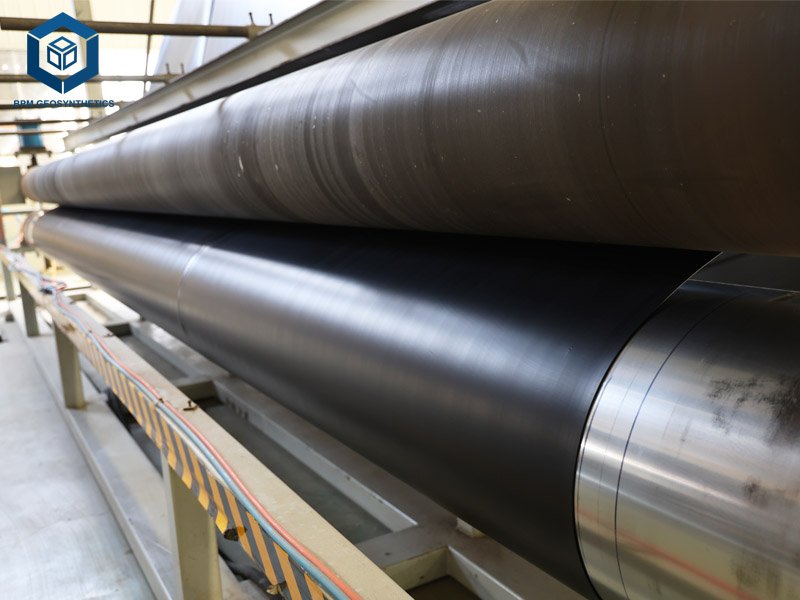
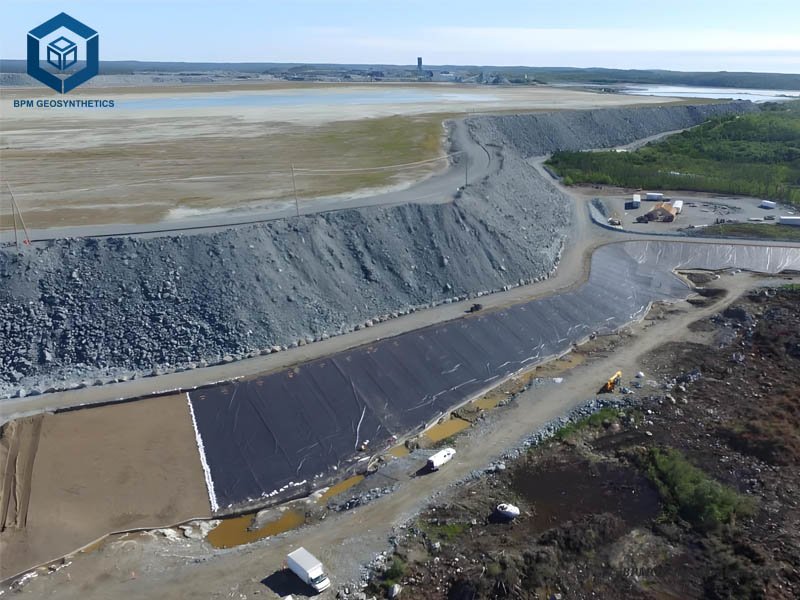
8. What Are Main Considerations When Choosing a Type of Pond Liner?
Project Requirements
- Application: Aquaculture needs 0.5–1 mm HDPE; decorative ponds use 0.75 mm EPDM, per earthshields.com.
- Load Conditions: High-traffic sites require 40 mil RPE with 400 lb puncture resistance, per agtec.com).
- Water Type: Fish-safe liners (NSF-certified) for aquaculture, per everything-ponds.com.
- Drainage Needs: Slopes (>10°) need textured liners, per ASTM D7466.
Environmental Conditions
- UV Exposure: RPE or covered HDPE for exposed ponds, per globalplasticsheeting.com.
- Temperature: EPDM withstands -40°C to 140°C, ideal for ponds, per extreme climates).
- Aquatic Safety: Ensure fish- and fish-plant-safe liners (NSF), per everything-ponds.com.
Thickness and Texture
- Thickness: 30 mil RPE for water; 40 mil for waste, per westernliner.com. Thicker liners (60 mil) suit mining, adding 20% durability.
- Texture: Textured HDPE improves slope stability by 15%, per ASTM D7466.
Budget and Installation
- Cost: HDPE ($0.5–$2/m²) is 30% cheaper than EPDM ($1–$3/m²). Bulk orders save 15–20%, per BPM.
- Labor: Certified welders reduce welders labor failures costs by 30%, per ASTM D6392).
- CQA: Testing ($0.1/m²) ensures 99% defect detection, per ASTM D5827.
Supplier Reliability
- Certifications: ISO 9001, GRI-GM13, ASTM, and CE compliance.
- Warranty: Prefer 5–10-year warranties, like Anjon’s LifeGuard EPDM, per anjonmfg.com.
- Support: BPM offers 24/7 assistance, and free samples, per bpmgeomembrane.com).
9. Is a Pond Liner Actually Waterproof?
Pond liners are 100% waterproof when manufactured to standards like GRI-GM13, with a hydraulic conductivity of <1×10^-7 cm/s (ASTM D5887), ensuring 99.9% water retention. HDPE, RPE, LLDPE, EPDM, DPE, and fish-safe PVC liners are designed specifically to hold water, per pondpeople.co.uk. However, waterproofing can be compromised by:
- Punctures: 10–15% failure rate without underlayment, per Geosynthetics Magazine.
- Seam Failures: Improper welding reduces seam strength by 20%, per ASTM D6392.
- Permeation: HDPE permits 1–2% hydrocarbon leakage over 20 years, per ScienceDirect.
Geotextiles and proper installation (vacuum/spark testing, ASTM D5827) ensure 99% waterproofing efficiency.
10. Final Thoughts
Pond liners are essential for water containment, driving the USD 1.87 billion market with applications in aquaculture, agriculture, and landscaping. HDPE and RPE liners, with 99.2% impermeability (<1×10^-13 cm/s), 27–80 kN/m tensile strength, and 20–100-year lifespans, offer cost-effective solutions ($0.5–$2/m²). However, disadvantages like puncture risks (15%), UV degradation (20% strength loss), installation complexity ($5,000–$50,000), and ESC (30% lifespan reduction) require careful planning. Geotextiles ($0.1–$0.3/m²), protective covers ($0.2–$0.5/m²), and skilled labor mitigate risks by 20–30%. Innovations like recycled materials and smart liners reduce environmental impact by 15% and repair costs by 20%. By selecting appropriate liners (HDPE, RPE, EPDM) and suppliers like BPM Geosynthetics, projects achieve 95% efficiency.
Contact BPM Geomembrane for custom solutions, free samples, and expert guidance to optimize your pond projects.

